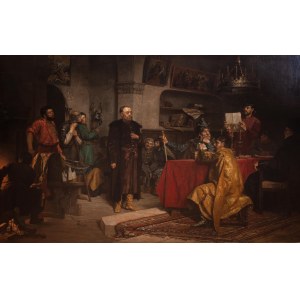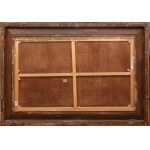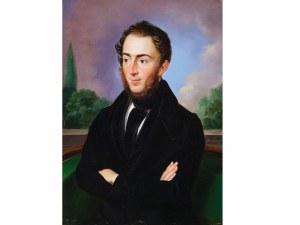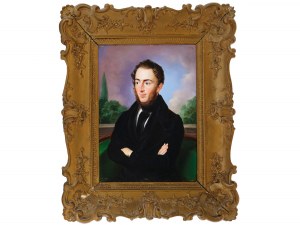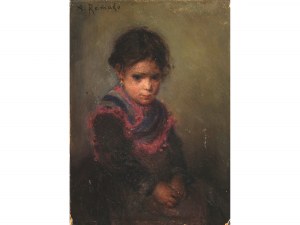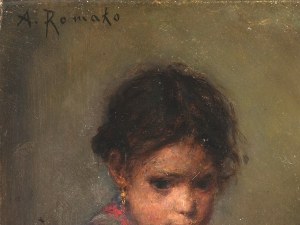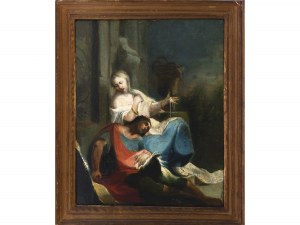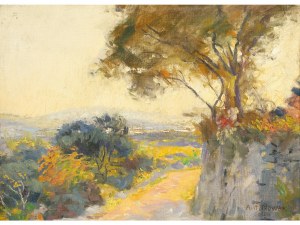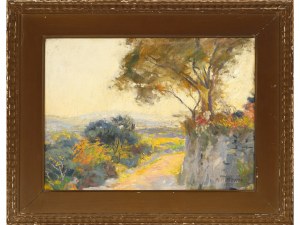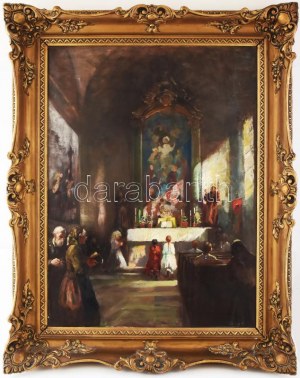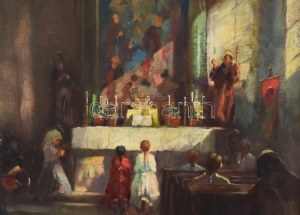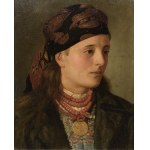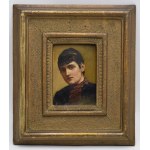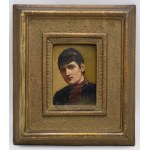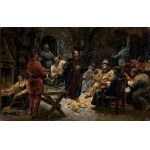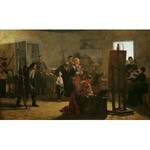oil, canvas, 100 × 160 cm
Signed, dated and described p. d.: "Antoni Jezierski.-/W Krakow 1888."
Provenance:
- 1888 r. - purchased by the Society of Friends of Fine Arts in Krakow
- 1902 r. - private collection, Lvov Mentioned:
- "Słownik artystów polskich i obcych w Polsce działających. Painters, Sculptors, Graphic Artists", edited by J. Maurin Białostocka and J. Derwojed, vol. III: "H-Ki", Ossoliński National Institute, Publishing House of the Polish Academy of Sciences, 1979, entry: "Jezierski Antoni", p. 288
Preceded by a small format sketch of the same subject - A. Jezierski, "Glinski before the court of boyars", before 1888, oil, canvas, 28.5 cm x 45 cm
The historical painting offered at auction was created a year after the artist completed his studies taken at the composition studio led by Jan Matejko at the School of Fine Arts in Krakow (years 1884-1887). The influence of the master is indisputable. The painting of this work was inspired by the colorful fate of the Lithuanian prince Michał Gliński, which also became the canvas for such 19th-century literary works as: "Historical Songs" by Jan Ursyn Niemcewicz, "Glinski. Tragedy in 5 acts in verse" by Franciszek Wężyk, and "Glinski - historical drama in 4 acts" by F. Kubal. The figure of the prince and his family was also included in an engraving included in Antoni Oleszczyński's publication "Wspomnienia. O Polakach co słynęli w obcych i odległych krajach. Descriptions and images". Jezierski himself approached several times to paint episodes from the life of Kniaz Gliński. In 1887, he completed the painting "Death of Zabrzezinski." And before the offered work was created, the artist preceded it with a much smaller sketch with a slightly different compositional arrangement, but referring to the same moment, when the prince stood before the court of boyars. What were the turns of fate that led to such an ending?
Mikhail Glinsky (c. 1470-1534) was a descendant of the "ancient Rus princes of Rurik blood descent, endowed by nature with astute understanding and reason, received a careful upbringing for that age, and then for a dozen years he was educated at foreign courts in the art of chivalry. Upon his return to the country he was pleasantly received from the monarch and not only elevated to a high dignity, that is, the court marshal of Lithuania, but soon became a trusted confidant of King Alexander [Jagiellon], who in all matters of government mainly relied on him." (J. Moraczewski, "Dwaj Zygmunci Jagielloni czyli Polska w pierwszej połowie XVI wieku. Part 1, [Sigismund I.] ", [n.m.], 1859, p. 8). The successes and growing influence enjoyed by the prince of Glinsky did not please everyone and brought him enemies, led by the governor of Troki, Jan Zabrzezinski. Sigismund I the Old, having assumed the throne after Alexander Jagiellon and having given heed to Zabrzezinski's incitements, removed Glinski from all offices. Unable to obtain top-down justice, Prince Michael, in an act of revenge, ordered the murder of the Governor of Troki. In 1508, together with his brothers Ivan and Vasily, he committed treason and went over to the Moscow side. Vasily III bestowed upon him the title of boyar, gave him estates in Borovsk and Yaroslavl and appointed him commander of a regiment. The ruler also promised Glinsky the governorship of Smolensk, but he did not fulfill his promise. Prince Mikhail, dissatisfied with such a turn of events, decided to offer his service to the King of Poland again and ensure his safe existence in the Lithuanian territories. The plan did not come to fruition, as Glinsky was captured near Borisov and put on trial. Vasily III accused him of treason and conspiring with Sigismund I the Old. As a result of the trial, Prince Mikhail was sentenced to imprisonment and confined to the dungeons, where he remained for a period of 13 years. Only with the intervention of Helena Vasilievna Glinskaya, Mikhail's niece, who became the wife of the Moscow ruler in 1526, was the kniaz released.
In his work, Antoni Jezierski chose to immortalize the moment of the verdict on Glinskaya in a suggestively narrative manner. Prince Michael is placed in the center of the composition. His silhouette is proudly erect, with only his right hand clenched into a fist, indicating the emotions that may have internally gripped him. Vasily III is seated at a table draped in red cloth, and with his finger he is most likely pointing at the executioner, located on the left side of the composition and frozen in anticipation, with an axe in his hand. The ruler is not looking at the accused, his gaze turned towards the boyars hidden from the viewer's eye, while his chin is supported on his hand in a gesture of thoughtfulness. On the right side of the composition is a figure reading the indictment to the assembled people, while below him is a secretary taking notes of everything. The scene painted is climactic - here is the fate of Prince Glinski being weighed, what will be the verdict on the offense committed? The work was painted with great attention to detail. The eye is primarily drawn to the brass chandelier decorated with openwork ornamentation, icons hanging on the walls, including St. George slaying a dragon and a woman's blanket lying on the floor. "Glinski before the court of boyars" by Jezierski is a high-class work, fully realizing all that is best in the genre of history painting. Here we have a reference to the adventurous and intrigue-filled story of Prince Michael, popular in the 19th century, which stimulates the viewer's imagination, and everything is depicted using excellent painting technique.
Recently viewed
Please log in to see lots list
Favourites
Please log in to see lots list



